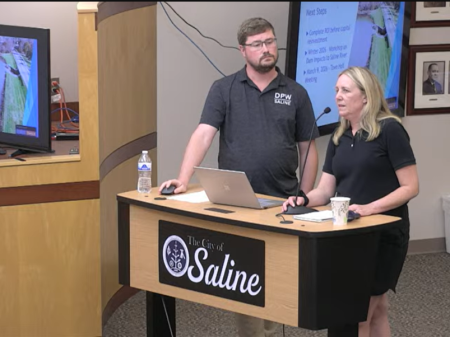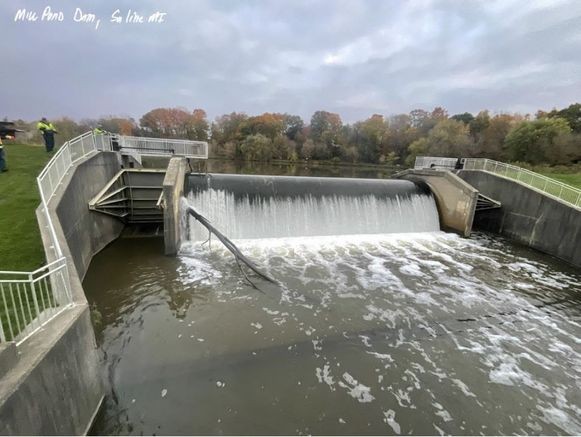Photo: The Saline River Dam in Saline, MI. Source: City of Saline
The Saline City Council heard an extensive presentation on Monday night, October 6, 2025, regarding the future of the Saline River dam. Engineers detailed the growing costs of maintaining the century-old structure and the city’s ongoing efforts to evaluate whether rehabilitation or removal is the most sensible option.
Aging Infrastructure and Rising Costs
City Engineer Tesha Humphriss outlined the history and current condition of the dam, which was initially built in the 1840s and rebuilt after an embankment failure in the 1970s. “Every single asset that we own has capital costs and ongoing operation and maintenance costs,” Humphriss said. “The older they get, the more it takes to bring them back up to their normal operating position.”
Humphriss noted that while the dam is categorized under “safety” due to potential downstream risks, it no longer serves its original purpose of powering a mill. And contrary to common belief, it does not provide flood control. “Only 8% of dams actually do,” she said. “Ours does not.”
A 2021 structural inspection identified repairs totaling about $200,000, but more recent assessments have raised the projected rehabilitation cost to $1–1.5 million. That figure includes cofferdams, spillway reconstruction, and work to meet evolving state regulations. “We have an asset that’s no longer serving its original purpose,” Humphriss said.

Ongoing Maintenance and Next Steps
Department of Public Works Director Zach Haapala summarized the city’s recent maintenance and safety work at the dam. “We’ve updated the dam level sensor and camera to identify when we need to raise the radial gates,” he said. “We’ve also removed damaged concrete, reinforced the embankment with geotextile fabric, and developed a required maintenance task list.”
He also showed updated renderings depicting how the area could look if the dam were removed, showing a narrower, more natural river channel and expanded parkland on both banks.
Next steps include completing a return-on-investment study comparing rehabilitation versus removal, followed by a public workshop this winter and a town hall next spring.
Councilmember Dean Girbach urged continued focus on both options. “We wanted two alternatives,” he said. “Do you feel we have those two alternatives right now to evaluate, or do we have more work to do?”
Humphriss responded, “We absolutely have more work to do to fully evaluate what it takes to rehabilitate the dam.”
Residents Push Back on Removal
During public comment, residents spoke firmly against removing the dam and losing Mill Pond.
One speaker said the dam can be repaired affordably and cited examples of other Michigan communities that have restored their dams instead of removing them. “All four dams from the 2020 break are being repaired,” the speaker said.
Another resident argued that cost estimates for removal do not reflect the whole picture. “Current cost estimates probably do not include all the items impacted by the dam removal, nor all of the benefits incurred by keeping the pond,” the speaker said, noting that Mill Pond is “the only place in Saline where people can canoe or kayak or fish.
Several residents raised concerns about escalating costs in other communities. One cited a dam removal project in Ohio where estimates “went from $50 million to over $100 million just for the silt alone.”
Another called on the city to improve communication with residents whose properties border the pond. “I’ve been hearing for the last couple years that people living on Saline River Drive, Pond View, and Mill Pond Manor would be sent letters,” the speaker said. “I haven’t received a letter… I’m really frustrated by this.”
A Decision Still Downstream
Mayor Marl agreed that future outreach should be more direct. “It would be best practice to provide direct communication to every adjacent property owner by first-class mail,” he said.
For now, the city remains in deliberation, with talk of possibly putting it up for public vote in 2026. Engineers and council members continue to balance the dam’s historic and recreational value against its growing maintenance demands and regulatory obligations.
The fate of Mill Pond, and whether Saline restores or reimagines it, remains a decision still downstream.





 8123 Main St Suite 200 Dexter, MI 48130
8123 Main St Suite 200 Dexter, MI 48130

